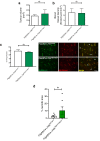Phosphorylation of pericyte FAK-Y861 affects tumour cell apoptosis and tumour blood vessel regression
- PMID: 33730293
- PMCID: PMC8292267
- DOI: 10.1007/s10456-021-09776-8
Phosphorylation of pericyte FAK-Y861 affects tumour cell apoptosis and tumour blood vessel regression
Erratum in
-
Correction to: Phosphorylation of pericyte FAK‑Y861 affects tumour cell apoptosis and tumour blood vessel regression.Angiogenesis. 2021 Aug;24(3):483-487. doi: 10.1007/s10456-021-09802-9. Angiogenesis. 2021. PMID: 34218398 Free PMC article. No abstract available.
Abstract
Focal adhesion kinase (FAK) is a non-receptor tyrosine kinase that is overexpressed in many cancer types and in vivo studies have shown that vascular endothelial cell FAK expression and FAK-phosphorylation at tyrosine (Y) 397, and subsequently FAK-Y861, are important in tumour angiogenesis. Pericytes also play a vital role in regulating tumour blood vessel stabilisation, but the specific involvement of pericyte FAK-Y397 and FAK-Y861 phosphorylation in tumour blood vessels is unknown. Using PdgfrβCre + ;FAKWT/WT, PdgfrβCre + ;FAKY397F/Y397F and PdgfrβCre + ;FAKY861F/Y861F mice, our data demonstrate that Lewis lung carcinoma tumour growth, tumour blood vessel density, blood vessel perfusion and pericyte coverage were affected only in late stage tumours in PdgfrβCre + ;FAKY861F/Y861F but not PdgfrβCre + ;FAKY397F/Y397F mice. Further examination indicates a dual role for pericyte FAK-Y861 phosphorylation in the regulation of tumour vessel regression and also in the control of pericyte derived signals that influence apoptosis in cancer cells. Overall this study identifies the role of pericyte FAK-Y861 in the regulation of tumour vessel regression and tumour growth control and that non-phosphorylatable FAK-Y861F in pericytes reduces tumour growth and blood vessel density.
Keywords: Angiogenesis; Cancer; Focal adhesion kinase (FAK); Pericytes.
© 2021. The Author(s).
Conflict of interest statement
KHD is a scientific advisor for Ellipses. KHD is joint applicant on Patent claims N421127GB and N417173GB. The other authors declare no conflicts of interest.
Figures




Similar articles
-
Tumor Angiogenesis Is Differentially Regulated by Phosphorylation of Endothelial Cell Focal Adhesion Kinase Tyrosines-397 and -861.Cancer Res. 2019 Sep 1;79(17):4371-4386. doi: 10.1158/0008-5472.CAN-18-3934. Epub 2019 Jun 12. Cancer Res. 2019. PMID: 31189647
-
Focal Adhesion Kinase (FAK) tyrosine 397E mutation restores the vascular leakage defect in endothelium-specific FAK-kinase dead mice.J Pathol. 2017 Jul;242(3):358-370. doi: 10.1002/path.4911. Epub 2017 Jun 1. J Pathol. 2017. PMID: 28444899 Free PMC article.
-
Pericyte FAK negatively regulates Gas6/Axl signalling to suppress tumour angiogenesis and tumour growth.Nat Commun. 2020 Jun 4;11(1):2810. doi: 10.1038/s41467-020-16618-6. Nat Commun. 2020. PMID: 32499572 Free PMC article.
-
Dual roles of FAK in tumor angiogenesis: A review focused on pericyte FAK.Eur J Pharmacol. 2023 May 15;947:175694. doi: 10.1016/j.ejphar.2023.175694. Epub 2023 Mar 24. Eur J Pharmacol. 2023. PMID: 36967077 Review.
-
The NG2 Proteoglycan in Pericyte Biology.Adv Exp Med Biol. 2018;1109:5-19. doi: 10.1007/978-3-030-02601-1_2. Adv Exp Med Biol. 2018. PMID: 30523586 Review.
Cited by
-
Selenomethionine Suppress the Progression of Poorly Differentiated Thyroid Cancer via LncRNA NONMMUT014201/miR-6963-5p/Srprb Pathway.Comb Chem High Throughput Screen. 2024;27(16):2419-2432. doi: 10.2174/0113862073286006231228070738. Comb Chem High Throughput Screen. 2024. PMID: 38173060
-
Targeting the tumour vasculature: from vessel destruction to promotion.Nat Rev Cancer. 2024 Oct;24(10):655-675. doi: 10.1038/s41568-024-00736-0. Epub 2024 Aug 29. Nat Rev Cancer. 2024. PMID: 39210063 Review.
-
A FAK Inhibitor Boosts Anti-PD1 Immunotherapy in a Hepatocellular Carcinoma Mouse Model.Front Pharmacol. 2022 Jan 18;12:820446. doi: 10.3389/fphar.2021.820446. eCollection 2021. Front Pharmacol. 2022. PMID: 35115949 Free PMC article.
-
Perspectives on Vascular Regulation of Mechanisms Controlling Selective Immune Cell Function in the Tumor Immune Response.Int J Mol Sci. 2022 Feb 19;23(4):2313. doi: 10.3390/ijms23042313. Int J Mol Sci. 2022. PMID: 35216427 Free PMC article. Review.
-
N6-methyladenosine modification of CENPF mRNA facilitates gastric cancer metastasis via regulating FAK nuclear export.Cancer Commun (Lond). 2023 Jun;43(6):685-705. doi: 10.1002/cac2.12443. Epub 2023 May 31. Cancer Commun (Lond). 2023. PMID: 37256823 Free PMC article.
References
Publication types
MeSH terms
Substances
Grants and funding
LinkOut - more resources
Full Text Sources
Other Literature Sources
Molecular Biology Databases
Miscellaneous

